Smoking and its effects on the skin (original) (raw)
Smoking and its effects on the skin — extra information
Synonyms:
Effects of tobacco smoke and nicotine on the skin
ICD-10:
K14.3, K13.24, Z72.0, T65.2, T65.29, F17.209, F17.218, F17.219, F17.200, T17.2, K13.2, K13.21, I73.1
ICD-11:
DA03.4, QE13, DA08.4, DD05, 6C4A.Z, 6C4A.Y, DA01.00, EE40.Y
SNOMED CT:
212899006, 365981007, 65568007, 102408007, 247439004, 292451006, 81934005, 414603003
Author: Dr Susan Simpkin, Medical Registrar, Waikato Hospital, Hamilton, New Zealand, 2010. Updated by Hon Assoc Prof Amanda Oakley, Dermatologist, Waikato Hospital, Hamilton, New Zealand, November 2016.
[Introduction ](/topics/smoking-and-its-effects-on-the-skin#Introduction
) [Smoking and skin damage ](/topics/smoking-and-its-effects-on-the-skin#Smoking and skin damage
) [Smoking and ageing skin ](/topics/smoking-and-its-effects-on-the-skin#Smoking and ageing skin
) [Smoking and wound healing ](/topics/smoking-and-its-effects-on-the-skin#Smoking and wound healing
) [Smoking and infections ](/topics/smoking-and-its-effects-on-the-skin#Smoking and infections
) [Smoking and skin cancer ](/topics/smoking-and-its-effects-on-the-skin#Smoking and skin cancer
) [Smoking and palmoplantar pustulosis ](/topics/smoking-and-its-effects-on-the-skin#Smoking and palmoplantar pustulosis
) [Smoking and psoriasis ](/topics/smoking-and-its-effects-on-the-skin#Smoking and psoriasis
) [Smoking and hidradenitis suppurativa ](/topics/smoking-and-its-effects-on-the-skin#Smoking and hidradenitis suppurativa
) [Smoking and vascular disease ](/topics/smoking-and-its-effects-on-the-skin#Smoking and vascular disease
) [Smoking and cutaneous lupus erythematosus ](/topics/smoking-and-its-effects-on-the-skin#Smoking and cutaneous lupus erythematosus
) [Smoking and oral diseases ](/topics/smoking-and-its-effects-on-the-skin#Smoking and oral diseases
) [Effect of smoking on medicines ](/topics/smoking-and-its-effects-on-the-skin#Effect of smoking on medicines
) [Smoking and skin conditions severity ](/topics/smoking-and-its-effects-on-the-skin#Smoking and skin conditions severity
) [Help to quit smoking ](/topics/smoking-and-its-effects-on-the-skin#Help to quit smoking
) [Cutaneous effects of smoking cessation](/topics/smoking-and-its-effects-on-the-skin#Cutaneous effects of smoking cessation)
Introduction
Skin and hair are exposed to various environmental noxious agents, including tobacco smoke. Tobacco smoke consists of thousands of substances that damage the skin, and nicotine itself is harmful.
Beyond its known links to cancer, lung and heart disease, smoking is associated with premature skin ageing, delayed wound healing, and increased infections, as well as a number of skin disorders, particularly psoriasis, hidradenitis suppurativa and cutaneous lupus erythematosus. There is a general observation that smokers tend to be more severely affected than non-smokers by the majority of inflammatory skin diseases — even acne —and various conditions are often more difficult to treat effectively in smokers.
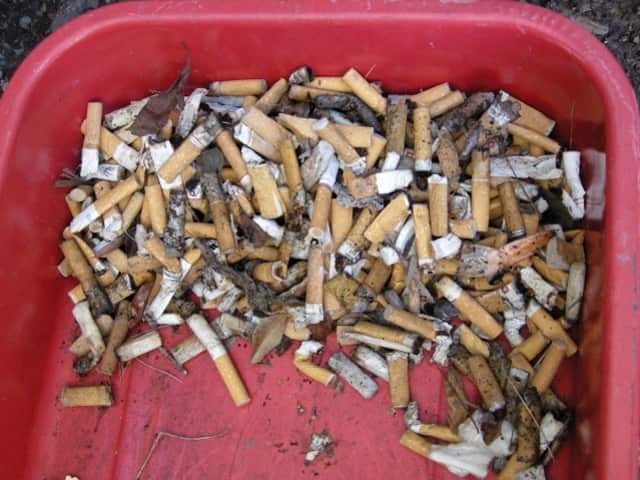
Cigarette butts
Cigarette butts
How does smoking damage the skin?
Tobacco smoke causes oxidative stress so that insufficient oxygen is supplied to the skin resulting in tissue ischaemia and blood vessel occlusion. It reduces innate and host immune responses, and induces metallo-proteinase MMP-1, an enzyme that specifically degrades collagen.
Nicotine replacement is safer for the skin than smoking, although nicotine itself induces vasoconstriction, inhibits inflammation, delays wound healing and accelerates skin ageing.
Smoking and ageing skin
Tobacco smoking has unpleasant temporary cutaneous and mucosal effects:
- Temporary yellowing of fingers and fingernails
- Discoloured teeth
- Black hairy tongue.
Longer term, the gaunt skin of a 40-year-old heavy smoker resembles that of non-smoking 70-year-old:
- Facial wrinkles and furrows (eg, crows’ feet at lateral canthus, vertical ear crease, smoker’s lines around lips)
- Baggy eyelids and slack jawline
- Uneven skin colouring: greyish, yellow with prominent blood vessels (telangiectasia)
- Dry, coarse skin.
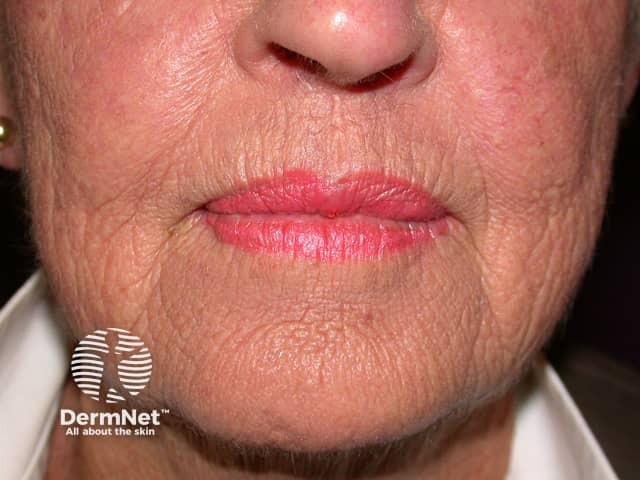
Smoking and its effects on the skin
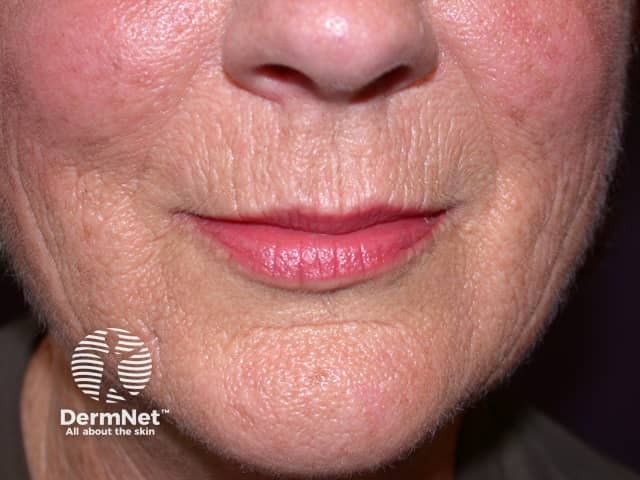
Smoking and its effects on the skin

Smoking and its effects on the skin
How does smoking cause ageing of the skin?
It is not certain exactly how smoking causes early ageing of the facial skin. Theories include:
- Heat from the cigarette directly burning the skin
- Changes in the elastic fibres of the skin (elastosis )
- Narrowing of blood vessels (vasoconstriction), which reduces blood supply to the skin and can cause changes in skin elastic fibres and loss of collagen
- Reducing vitamin A levels and moisture of the skin.
Smoking and wound healing
Smoking delays wound healing, including skin injuries and surgical wounds. It increases the risk of wound infection, graft or flap failure, death of tissue and blood clot formation. The reasons for this are unclear but involve:
- Vascoconstriction and lack of oxygen reaching skin cells
- Delayed migration of keratinocytes
- Decreased collagen synthesis
- Delayed growth of new blood vessels within the wound.
Smoking contributes to the development and persistence of leg ulcers, particularly arterial ulcers, diabetic foot ulcers and calciphylaxis.

Venous ulcer
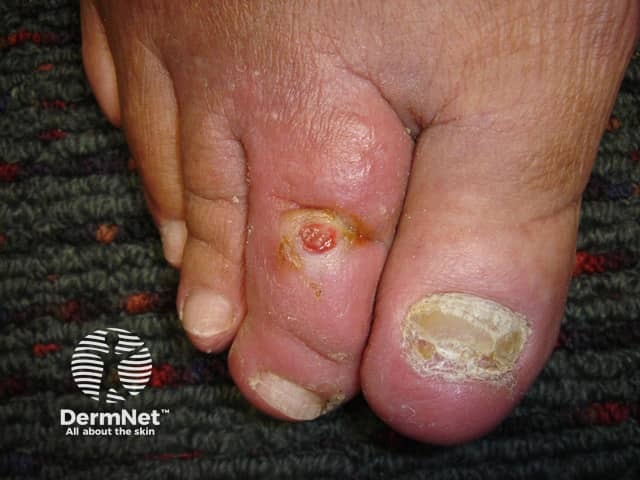
Diabetic foot ulcer
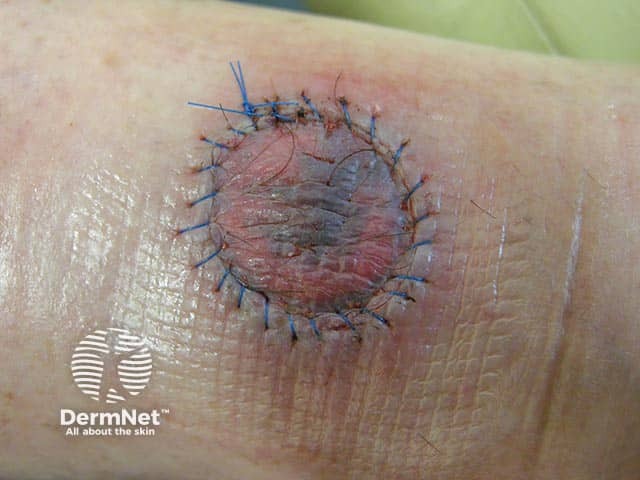
Failing skin graft
Smoking and infections
Smoking is associated with a greater likelihood or severity of:
- Bacterial wound infections, most often caused by Staphylococccus aureus and Streptococcus pyogenes
- Candida albicans infection, particularly in the mouth
- Viral infections, especially human papillomavirus (HPV), including genital warts.
If you have genital warts and you smoke, you have a greater chance of developing wart-virus associated cancers, including cervical cancer, vulval intraepitheial cancer, vulval cancer or penile intraepithelial cancer.
Smoking and skin cancer
Smoking cigarettes doubles the risk of developing a type of skin cancer called squamous cell carcinoma, compared to non-smokers. There is also an increased risk of oral leukoplakia (precancer) and oral cancer; 75% of cases of oral cancer and lip cancer occur in smokers. Smoking does not appear to increase the risk of basal cell carcinoma.
Smoking cessation reduces the risk of metastasis (spread) from lip cancer by 2–3-fold.

Lip cancer (squamous cell carcinoma)
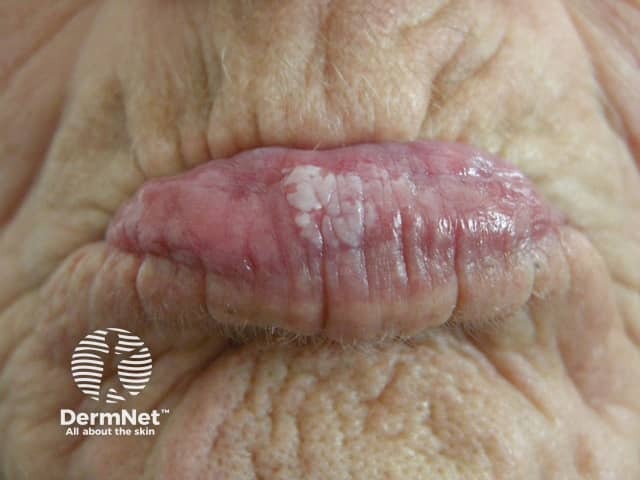
Oral leukoplakia
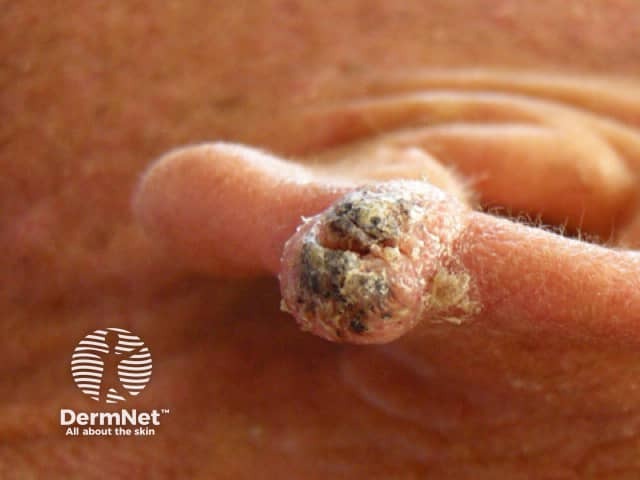
Ear cancer (squamous cell carcinoma)
Smoking and palmoplantar pustulosis
Palmoplantar pustulosis is treatment-resistant, chronic, and disabling dermatosis characterised by pustules, erythema and scaling on the soles and palms. It mainly affects middle-aged women, >90% of whom smoke. The mechanism relates to nicotine binding with acetylcholine receptors in the sweat gland and duct, to change their structure and induce inflammation.
Cessation of smoking gradually results in improvement and the pustules may eventually clear up in many patients.
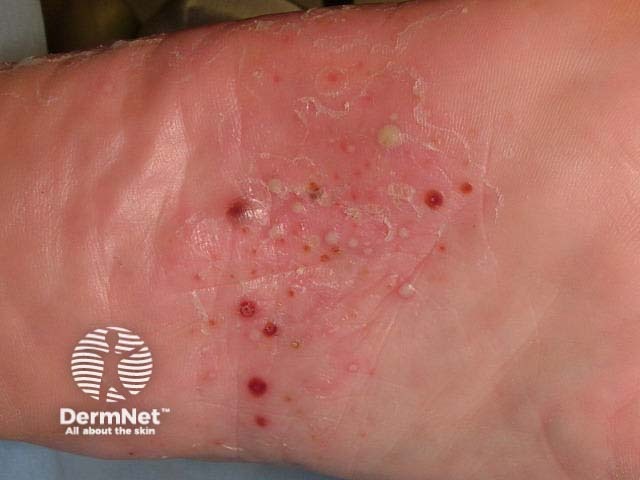
Plantar pustulosis
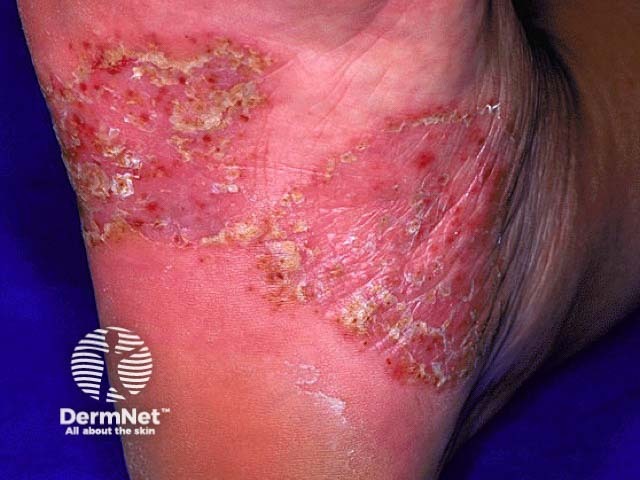
Plantar pustulosis
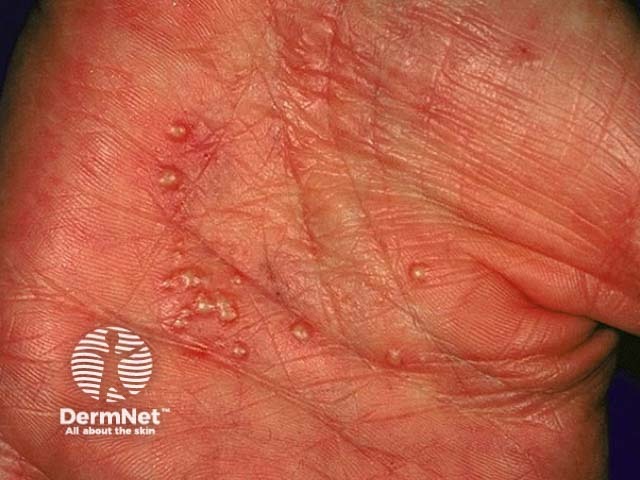
Palmar pustulosis
Smoking and psoriasis
Several studies have confirmed that smokers tend to have more extensive and severe psoriasis than those that do not. Patients with chronic plaque psoriasis smoke more than patients without psoriasis. The research is confounded by those with obesity or metabolic syndrome and quality of life issues.
The mechanism appears to be that smoking induces inflammatory mediators and promotes keratinocyte proliferation. Nicotine itself binds to dendritic cells, T-cells and keratinocytes.
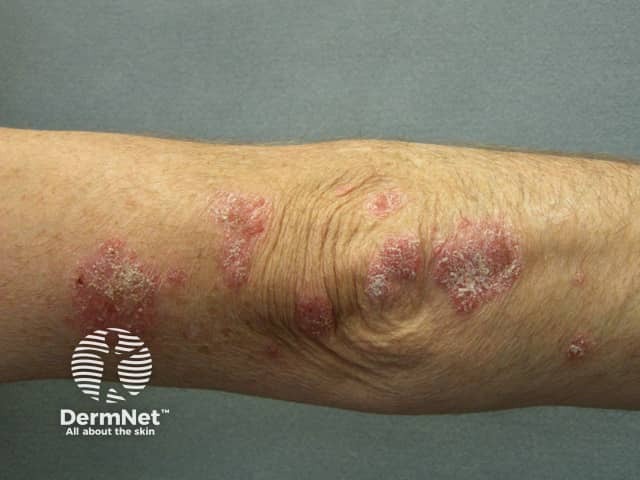
Smoking and psoriasis
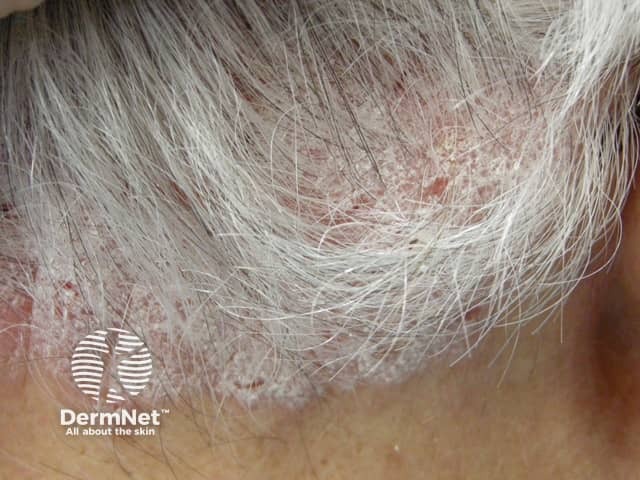
Smoking and psoriasis

Plaque psoriasis
Smoking and hidradenitis suppurativa
The majority of patients with hidradenitis suppurativa (HS) are smokers, and smokers have a greater burden of disease than non-smokers. There is genetic predisposition to HS, and it is particularly prevalent in obese women. The pathogenesis involves nicotine/acetylcholine-induced follicular occlusion, follicular rupture, and immune dysregulation. Smokers respond poorly to current treatment options.
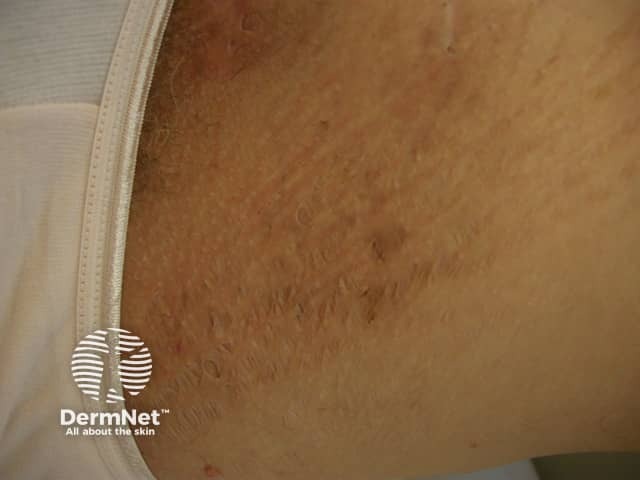
Smoking and hidradenitis suppurativa
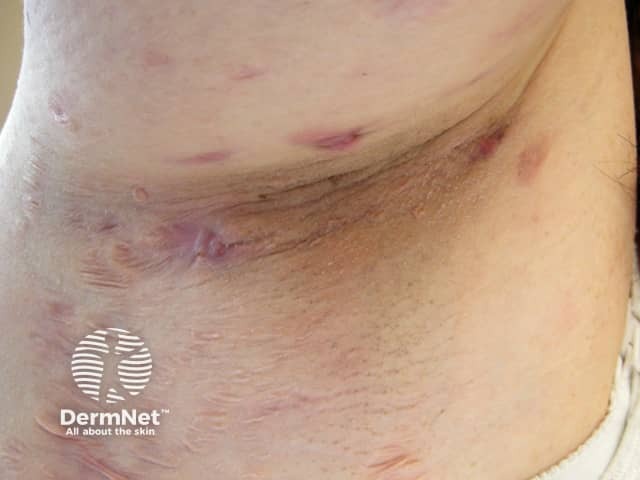
Smoking and hidradenitis suppurativa
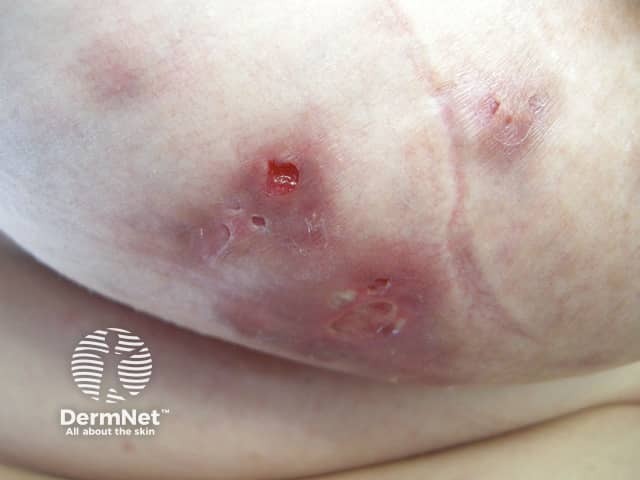
Smoking and hidradenitis suppurativa
Smoking and vascular disease
Nicotine causes vasoconstriction and hypercoagulability, increasing the chance of blood clots occluding blood vessels.
Smoking can aggravate or initiate:
- Chilblains
- Frostbite
- Primary or secondary vasospastic disease (Raynaud phenomenon)
- Ulceration, in patients with systemic sclerosis
- Thromboangiitis obliterans (Buerger disease), in which blood clots occur in small blood vessels
- Cholesterol emboli associated with atherosclerosis
- Thrombosis caused by thrombophilia, antiphospholipid syndrome or drugs — including oral contraceptives.
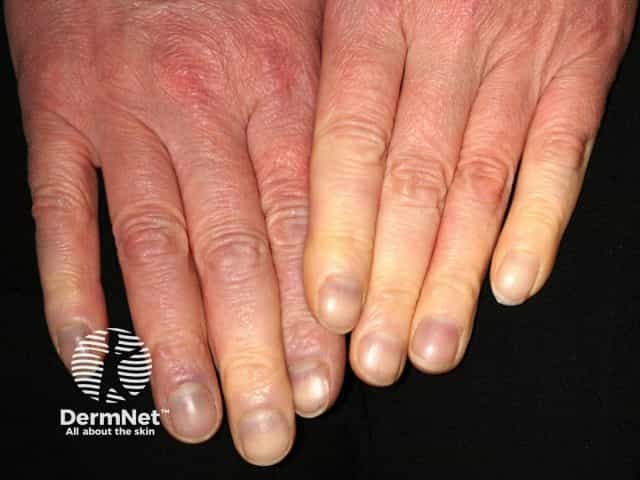
Raynaud phenomenon
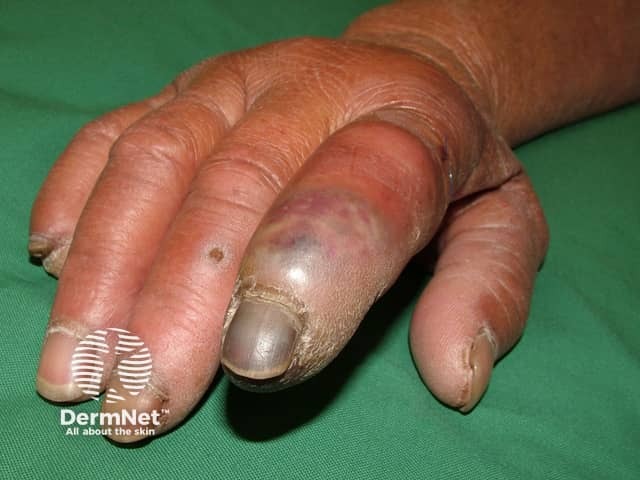
Antiphospholipid syndrome
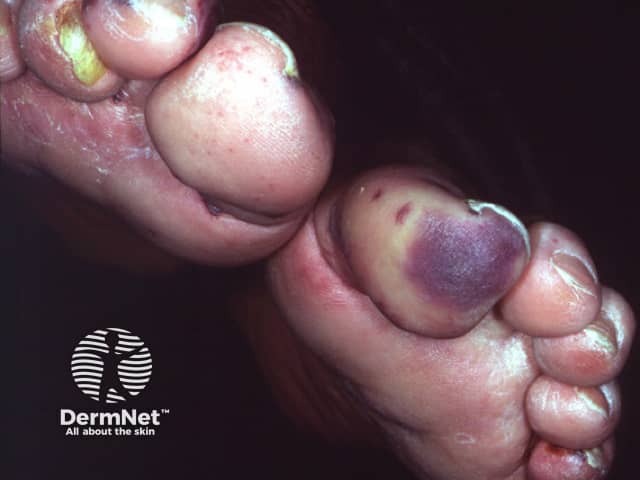
Cholesterol emboli
Smoking and cutaneous lupus erythematosus
There is more than ten-fold risk of chronic cutaneous lupus erythematosus (especially discoid lupus erythematosus) in smokers compared to non-smokers. Smoking increases autoimmune activity by activating the lymphocytes. There is also suspicion that treatment of chronic cutaneous LE is less effective in smokers.
Treatment of cutaneous lupus erythematosus with hydroxychloroquine and other medications is less effective in smokers.
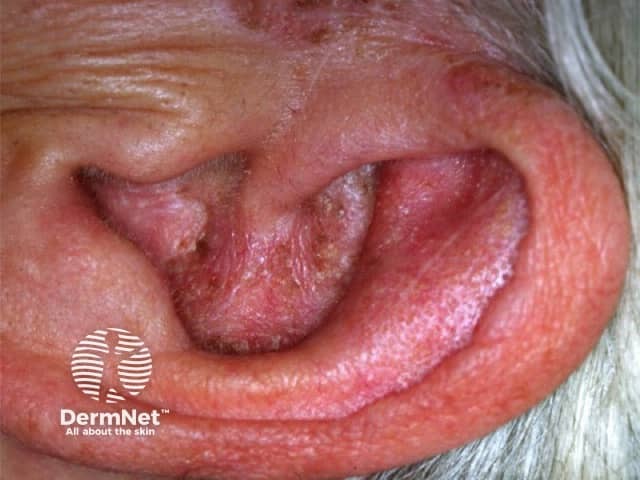
Smoking and discoid lupus erythematosus
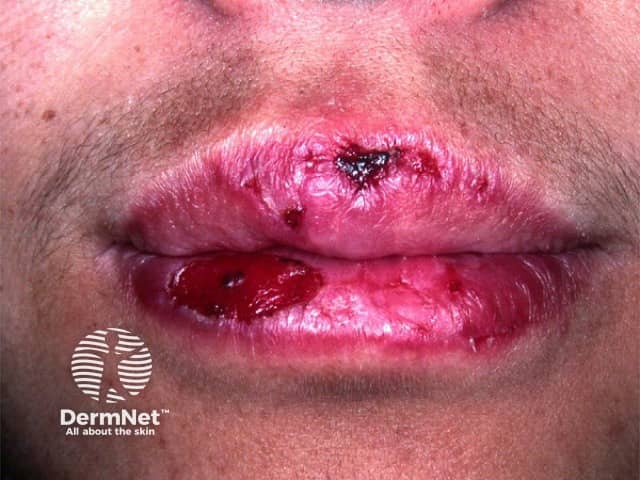
Smoking and discoid lupus erythematosus
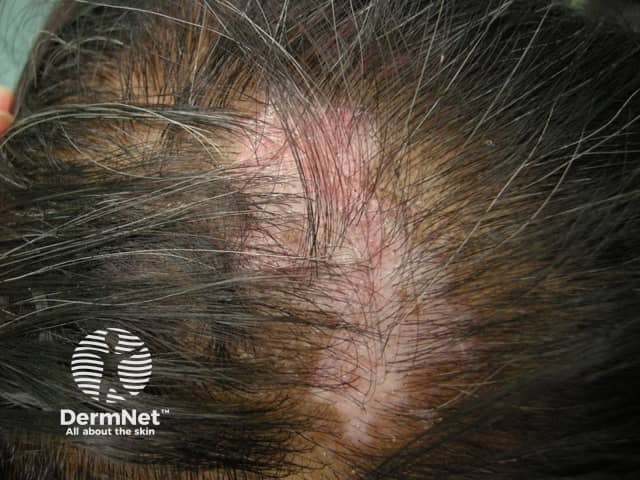
Smoking and discoid lupus erythematosus
Smoking and oral diseases
Conditions affecting the mouth tend to be more common in smokers. These include:
- Oral candidiasis (thrush)
- Oral lichen planus and erosive lichen planus
- Hairy tongue (lingua villosa). In this condition the surface of the tongue has elongated hair-like processes and is yellow, brown, green or black due to bacterial overgrowth. The condition is due to soft diet, poor oral hygiene, lack of saliva and smoking.
- Nicotine stomatitis
- Hairy leukoplakia associated with HIV infection
- Gingival enlargement and gingivitis
- Actinic cheilitis ie, dry peeling lips due to sun damage.
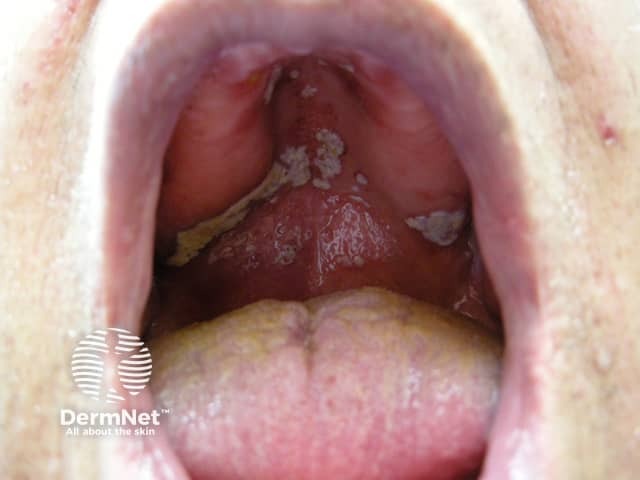
Oral candidiasis
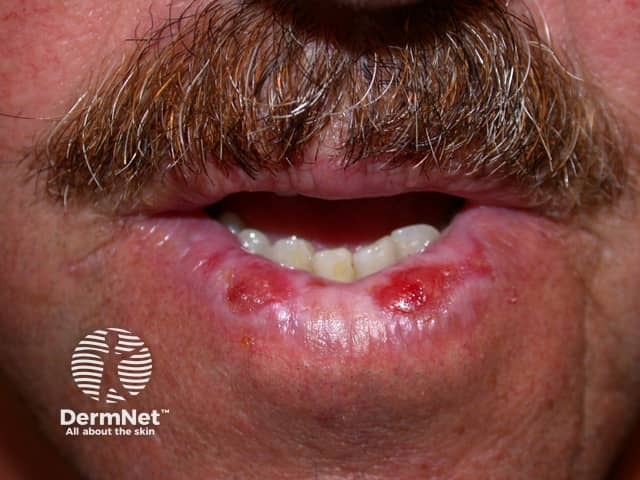
Cheilitis
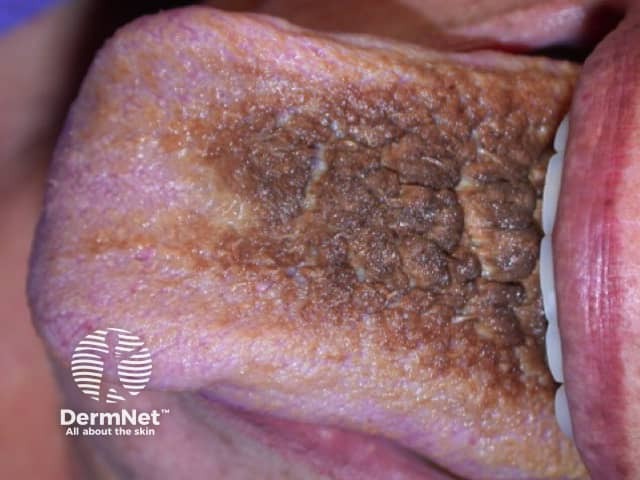
Black hairy tongue
Effect of smoking on medicines
Polycyclic aromatic hydrocarbons from smoking induces CYP1A2 enzymes in the liver. These enzymes destroy toxins. The result is that smokers need higher doses of many medicines compared to non-smokers to achieve the same result. These include insulin, pain relievers, antipsychotics, anticoagulants, caffeine and alcohol.
Alcohol intake and caffeine intake are on average double in smokers. This tolerance of alcohol and caffeine is quickly lost when a smoker stops smoking. Previously tolerated amounts of alcohol and caffeine can thus result in unexpected toxicity.
Alcohol ingestion can also lead to smoking more.
Are any conditions less severe in smokers than in nonsmokers?
Some inflammatory diseases are less common or less severe in smokers than non-smokers. These include:
- Aphthous ulcers
- Rosacea
- Labial herpes simplex
- Pemphigus vulgaris
- Dermatitis herpetiformis
- Pyoderma gangrenosum.
However, smoking is not recommended as treatment due to its adverse effects and risk of addiction.
How can I get help to stop smoking?
If you want to stop smoking or are thinking about quitting, there are people and services who can help.
- Telephone support. Quit-lines can help you form a cessation plan and offer you information about quit aids and support services in your area. In New Zealand, contact Quitline on 0800 778 778.
- Consult your family doctor. Most general practitioners can offer help and information about stopping smoking.
- Nicotine replacement. Nicotine-containing patches, gum, lozenges, nasal spray and/or inhalers may help in the first few weeks. Doses may need to be higher in heavy smokers or heavy drinkers.
- Nicotine agonist, such as varenicline (Champix™), or dopamine reuptake inhibitor, such bupropion (Zyban™). Your doctor can advise you on medicines that can help you break the habit.
- Vaping or e-cigarettes (also called electronic nicotine delivery systems). Check out the pros and cons. U.S. Surgeon General calls electronic cigarettes a “major health concern”, especially for youths, due to addiction and potential long-term harm to brain development and respiratory health including cancer.
- Other options include services offered by hypnotherapists, pharmacists, acupuncturists and natural therapists.
A combination of approaches is often best. A meter to measure carbon monoxide in breath can be used to guide treatment.
What are the cutaneous effects of smoking cessation?
Nicotine-containing patches, gum, lozenges, nasal spray, inhalers and e-cigarettes may or may not be beneficial to the skin in patients attempting to stop smoking.
Cutaneous side effects may result in poor patient adherence to treatment.
- Methacrylates and nicotine in transdermal patches have caused leukocytoclastic vasculitis and allergic contact dermatitis.
- Nicotine gum/lozenges/spray/inhalant can cause mouth/throat/nasal soreness and have been associated with acute urticaria.
- The nicotinic acetylcholine receptor agonists varenicline may cause dry mouth, exanthem, and acute generalised pustulosis.
- Bupropion has been reported to cause dry mouth, serum sickness–like reaction, aquagenic pruritus, subacute cutaneous lupus erythematosus, acute urticaria, angioedema, generalised psoriasis, pustular and erythrodermic psoriasis, erythema multiforme, Stevens Johnson syndrome, and drug hypersensitivity syndrome.
References
- Daniell HW. Smoker’s wrinkles. A study in the epidemiology of ‘crow’s feet’. Annals of Internal Medicine 1971; 75: 873–80. PubMed
- Kennedy et al. Effect of smoking and sun on the ageing skin. The Journal of Investigative Dermatology 2003; 120(4): 548–54. PubMed
- Leung, et al. Epidemiology and Health Services Research: Is skin ageing in the elderly caused by sun exposure or smoking? BJD 2002; 147: 1187–91. PubMed
- Just, et al. Effect of smoking on skin elastic fibres: morphometric and immunohistochemical analysis. The British Journal of Dermatology 2007; 156: 85–91. PubMed
- Mills. Smoking and skin disease. Int J Dermatol 1993; 32 (12): 864–5. PubMed
- Karagas, et al. Risk of subsequent basal cell carcinoma and squamous cell carcinoma of the skin among patients with prior skin cancer. JAMA 1992; 267:3305–10. PubMed
- Shahrad, et al. Smoking and Psoriasis. Skinmed 2005; 4(3): 174–6. PubMed
- Liu, et al. Psoriasis: genetic associations and immune system changes. Genes and Immunity 2007; 8: 1–12, vii. PubMed
- Naldi, et al. Cigarette Smoking, Body Mass Index, and Stressful Life Events as Risk Factors for Psoriasis: Results from an Italian Case–Control Study. The Journal of Investigative Dermatology 2005; 101: 61–7. PubMed
- Kurzen, et al. What causes hidradenitis suppurativa? Controversies in Experimental Dermatology 2008; 17: 455–72. PubMed
- Hana, et al. Functional significance of non-neuronal acetylcholine in skin epithelia.Life Sciences 2007; 80 (24-25): 2214–20. PubMed
- Vander Straten, et al. Tobacco use and skin disease. Southern Med J 2001; 94 (6): 621–34. PubMed
- Harrison, et al. Cigarette smoking as a significant risk factor for digital vascular disease in patients with systemic sclerosis. Arthritis Rheum 2002; Vol. 46 (12): 3312–6. PubMed
- Miot, et al. Association between discoid lupus erythematosus and cigarette smoking: A case-control study. Dermatology 2005;211:118–122. PubMed
On DermNet
- Nicotine stomatitis
- Carbon monoxide poisoning
- Ageing skin
- Cannabinoids in dermatology
- Cutaneous lupus erythematosus
- Facial lines and wrinkles
- Hidradenitis suppurativa
- Palmoplantar pustulosis
- Psoriasis
- Skin cancer
- Oral cancer
- Systemic sclerosis
- Carbon monoxide poisoning
- Vulval cancer
Other websites
- Cutaneous Manifestations of Smoking – Medscape Reference
- Stop Smoking — American Lung Association
- ASH New Zealand
- Quitline New Zealand
- The effects of smoking on the body — Healthline
- Advice on the use of E-Cigarettes — New Zealand Ministry of Health
- Tobaccofreelife
- Nicotine Replacement Therapy – Always prescribe enough – SafeRx
- Smokefree Pharmacotherapy — SafeRx
Books about skin diseases
Other recommended articles

ADVERTISEMENT